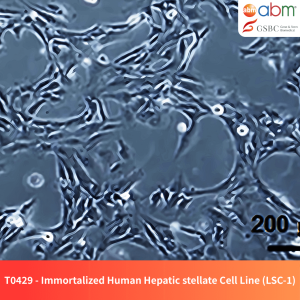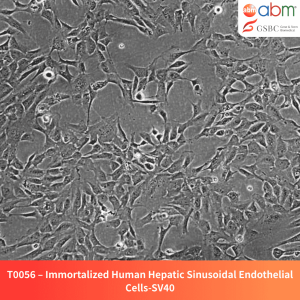Product Details
- Catalog Number: T0446
- Unit Size: 1 x 10⁶ cells / 1.0 mL
- Species: Human (Homo sapiens)
- Tissue Source: Heart (Ventricle)
- Cell Type: Immortalized Fibroblast Cells
- Growth Properties: Adherent, multipolar
- Biosafety Level: BSL-2
- Storage: Vapor phase of liquid nitrogen (-130°C or below)
- Shipping: Shipped on dry ice
- Format: Cryopreserved frozen cells
Overview
Immortalized Human Cardiac Fibroblasts play a crucial role in maintaining cardiac structure and function by synthesizing extracellular matrix, cytokines, and growth factors. These cells respond dynamically to myocardial injury, contributing to scar formation, fibrosis, and hypertrophy. The cells were immortalized using lentiviral transduction of the SV40 Large T antigen, enabling extended culture and enhanced experimental reproducibility. They provide an excellent in vitro model for cardiac research, including myocardial remodeling and fibrosis-related studies.
Key Features and Benefits
- Extended Culture Capability: Immortalized to enable long-term studies without senescence.
- Reproducibility: Ensures consistent results for cardiac fibrosis and remodeling research.
- Ideal for Cardiac Research: Supports studies on cardiac fibroblast function, fibrosis, and myocardial response to injury.
- Optimized for Growth: Adapted to specific media and extracellular matrices for enhanced viability.
- Adherent Growth Properties: Facilitates easy handling and maintenance in culture.
Culture & Handling Guidelines
Recommended Culture Conditions
- Coating: Use PriCoat™ T25 Flasks (G299) or Applied Cell Extracellular Matrix (G422) for optimal adhesion.
- Growth Medium: PriGrow IV (TM004) supplemented with:
- 10% Fetal Bovine Serum (FBS)
- 1mM Non-Essential Amino Acids (NEAA) (Cat. No.: TM068)
- 2mM L-glutamine (Cat. No.: G275)
- 5µg/mL insulin (Cat. No.: TM053)
- 1% Penicillin/Streptomycin (Cat. No.: G255)
- Incubation Conditions: Maintain at 37°C in a humidified atmosphere with 5% CO₂.
- Seeding Density: 40,000 – 50,000 cells/cm²
- Doubling Time: 48 – 58 hours
Thawing Protocol
- Quickly thaw cells in a 37°C water bath (maximum 2 minutes). Keep the vial cap above water level to avoid contamination.
- Decontaminate the vial by spraying with 70% ethanol and transfer to a biosafety cabinet.
- Add thawed cells to a sterile 15mL conical tube containing 5mL of pre-warmed complete growth medium.
- Centrifuge at 125xg for 5-7 minutes.
- Aspirate the supernatant, gently resuspend the cell pellet in fresh complete medium, and seed into a pre-coated T25 flask.
- Incubate under recommended conditions and allow cells to recover before passaging.
Subculturing Guidelines
- Aspirate the old medium and rinse cells with PBS.
- Add 2-3 mL of pre-warmed 0.25% Trypsin-EDTA and incubate at 37°C until cells detach (~2-10 minutes).
- Neutralize trypsin by adding an equal volume of complete medium.
- Centrifuge at 125xg for 5 minutes, aspirate the supernatant, and resuspend the pellet in fresh growth medium.
- Seed cells at the appropriate density into new culture vessels.
- Incubate under recommended conditions and monitor for confluency.
Cryopreservation Guidelines
- Cryopreservation Medium: Use Cryopreservation Medium (TM024) or complete growth medium supplemented with 10% DMSO.
- Freezing Protocol: Freeze at a controlled rate (-1°C per minute) before transferring to liquid nitrogen storage.
Related Products
- Recombinant Human FGF2 (E. coli) – Z101455
- Recombinant Human TGF Beta-1 (TGFB1) – Z101555
- Recombinant Human CTGF (E. coli) – Z102025
Disclaimer
- This product is intended for research use only and is not approved for human or animal therapeutic applications.
- Product performance may vary under different culture conditions. Users should validate experimental suitability before use.
- Storage below -130°C is required to maintain viability. Any deviations from recommended handling protocols may affect performance.
- The supplier is not responsible for any results derived from misuse of this product.
Reference
- Dolan, Eimear B., et al. “A bioresorbable biomaterial carrier and passive stabilization device to improve heart function post-myocardial infarction.” Materials science and engineering: C 103 (2019): 109751.
- Gałdyszyńska, Małgorzata, et al. “The stiffness‐controlled release of interleukin‐6 by cardiac fibroblasts is dependent on integrin α2β1.” Journal of Cellular and Molecular Medicine 24.23 (2020): 13853-13862.




